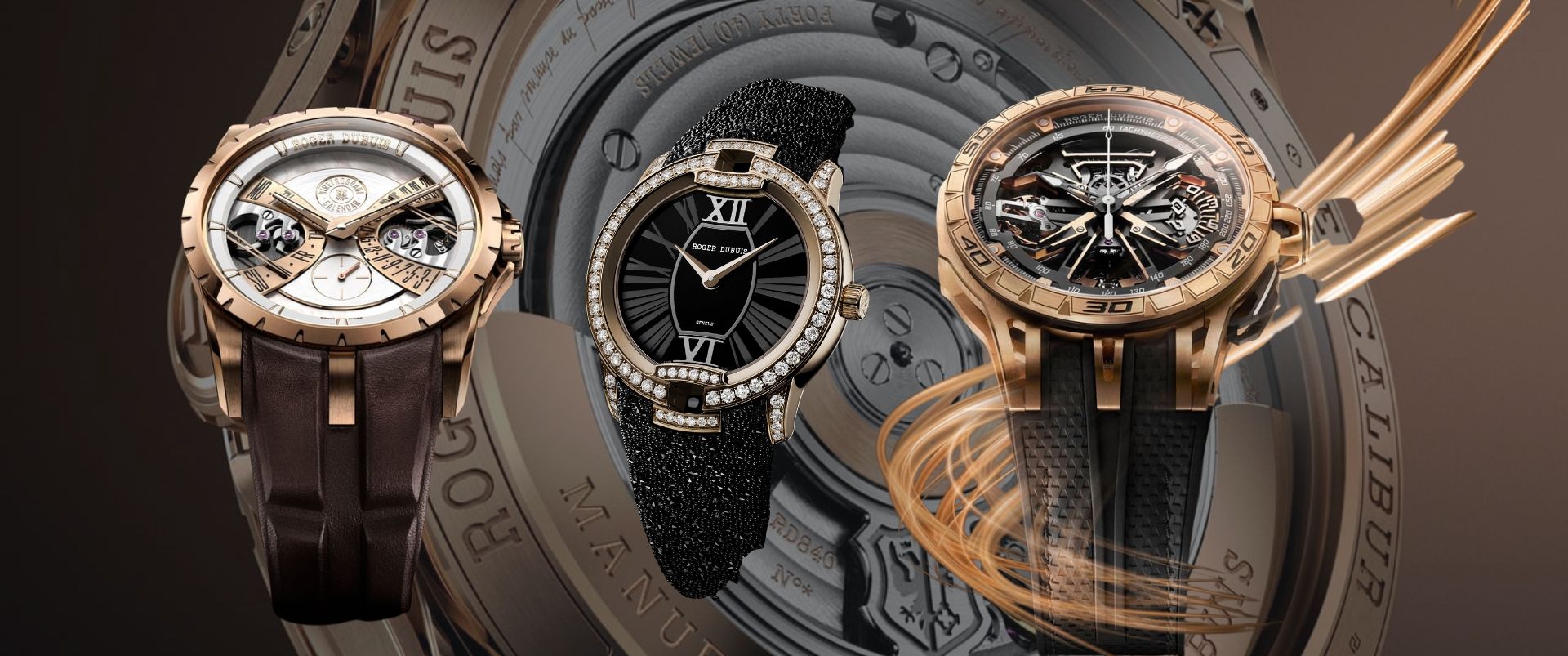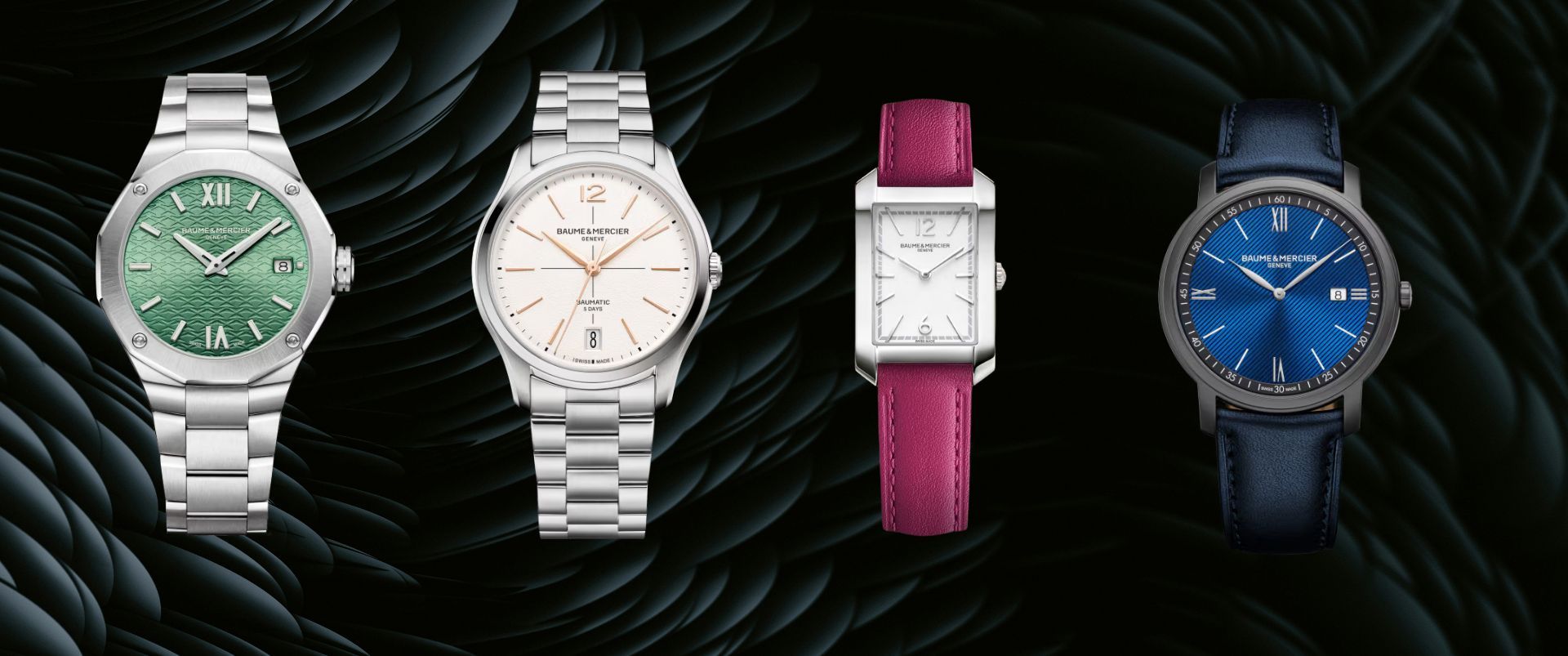Ganesh Chaturthi 2025 Special: Four Timepieces, Four Techniques
As millions across India celebrate Ganesh Chaturthi, the air fills with devotional fervor, elaborate pandals rise in every neighborhood, and the beloved elephant-headed deity's presence permeates every aspect of cultural life. Yet in the rarefied world of haute horlogerie, Lord Ganesha's divine form has found expression through some of the most technically sophisticated and culturally profound timepieces ever created. The convergence of Swiss watchmaking excellence with Hindu spirituality represents more than mere luxury—it embodies a deep respect for cultural heritage translated through centuries-old craftsmanship techniques. As we witness the festive season of 2025, few luxury manufacturers have dared to capture Ganesha's essence on their dials, each employing distinctly different métiers d'art to honor the remover of obstacles and patron of arts and sciences.
The Magnificent Four: Technical Mastery Meets Divine Artistry
1. Blancpain Villeret Métiers D'Art Ganesh - The Art of Shakudō and Damascening
Blancpain's interpretation stands as perhaps the most technically ambitious Ganesha timepiece ever created, winning Switzerland's top watchmaking prize for artistic merit. The manufacture's artisans employed two ancient techniques that require decades to master.
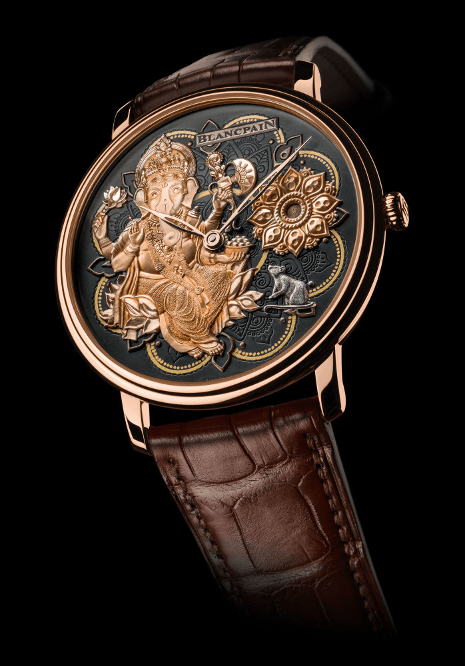
Shakudō Technique Analysis: The dial's distinctive black patina emerges from shakudō, a traditional Japanese alloy of gold and copper. Blancpain's craftsmen heat-treat this alloy to achieve controlled oxidation, creating the deep, lustrous black surface that serves as Ganesha's backdrop. The process demands precise temperature control—too little heat fails to develop the patina, while excessive heat destroys the alloy's structural integrity. Master artisans spend years learning to read the metal's color changes during oxidation, making each dial a testament to individual skill.
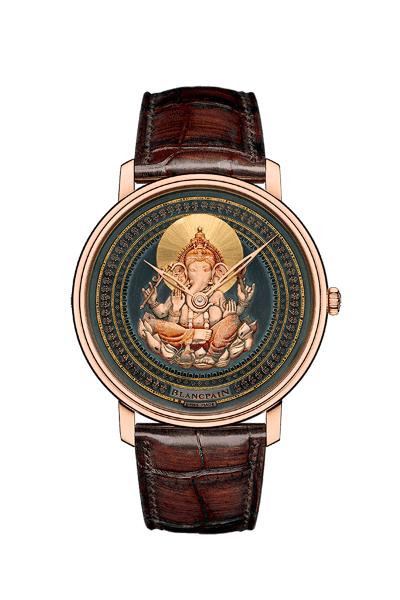
Damascening Excellence: The intricate gold detailing of Ganesha's form emerges through damascening, where artisans carve microscopic troughs into the dial surface using specialized gravers. Pure gold threads, no thicker than human hair, are then hammered into these channels with wooden mallets. The process requires extraordinary precision—one misplaced strike can ruin weeks of preparation work. Each line of Ganesha's trunk, crown, and robes represents individual gold inlays, painstakingly burnished to achieve seamless integration with the base metal. The damascening on this piece extends to Ganesha's traditional attributes: the modak (sweet dumpling) in his lower left hand, the abhaya mudra (blessing gesture), and the intricate patterns of his dhoti. Blancpain's artisans spent over 120 hours per dial completing this artistic tour de force.
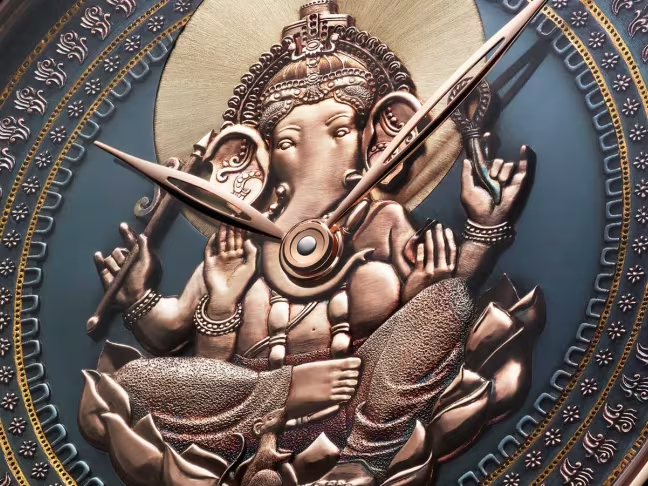
2. Chopard L.U.C XP Urushi Ganesh Special Edition (Limited to 10 pieces) - Japanese Maki-e Mastery
Chopard's collaboration with Japanese urushi masters represents a fascinating cultural fusion—Swiss precision meeting Japanese artisanal tradition to honor a Hindu deity. The 39.5mm ethical rose gold case houses an ultra-thin 3.30mm L.U.C Calibre 96.17-L movement, but the true marvel lies in the dial's Maki-e technique.
Urushi Lacquer Foundation: The process begins with multiple applications of urushi lacquer, derived from the Toxicodendron vernicifluum tree sap. Each layer requires curing in controlled humidity chambers for specific periods. The artisan applies up to fifteen layers, with intermediate polishing using charcoal powder between applications. This creates an incredibly durable, luminous base that will maintain its luster for centuries.
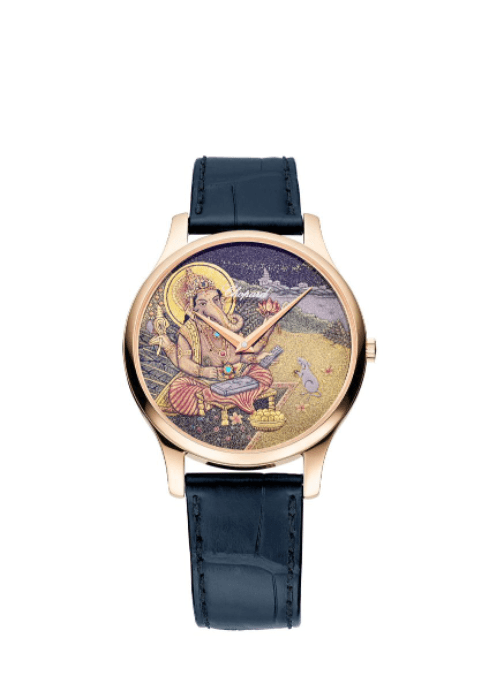
Maki-e Gold Powder Application: Ganesha's form emerges through the strategic application of gold powder between lacquer layers. Using brushes crafted from rat's hair—chosen for their exceptional fineness and resilience—the artisan creates Ganesha's iconic silhouette. The gold powder, ground to microscopic particles, is applied through bamboo tubes with surgical precision. The technique's sophistication lies in creating dimensional depth through powder density variation. Ganesha's face receives denser gold application, creating prominence, while his limbs use graduated density to suggest natural shadowing. The final layer of clear urushi seals the composition, creating the illusion of gold floating within crystal-clear depths.
3. Chopard L.U.C Quattro Spirit 25 Ganesh Edition (Limited to 5 pieces) - Grand Feu Enamel Artistry
The rarest of Chopard's Ganesha offerings employs grand feu enamel, one of horology's most challenging decorative arts. The 40mm rose gold case, adorned with hand-engraved Ganesha motifs, frames a dial that requires multiple high-temperature firing cycles.
Grand Feu Enamel Process: The artisan begins with a copper dial base, applying successive layers of powdered glass enamel mixed with water and organic binding agents. Each layer undergoes firing at temperatures exceeding 800°C in specialized kilns. The process demands absolute temperature precision—variations of even 20 degrees can cause color shifts, bubbling, or complete failure. Ganesha's image emerges through the careful application of metallic oxides that create specific colors when fired. Gold produces ruby red, copper creates turquoise, and silver yields various yellows. The artisan must predict how these colors will interact during firing, as chemical reactions in the kiln can dramatically alter the final appearance. The eight-day power reserve movement reflects the piece's exceptional nature—the L.U.C Quattro system employs four vertically-stacked mainspring barrels, requiring precise engineering to manage the extended energy storage while maintaining chronometric precision.
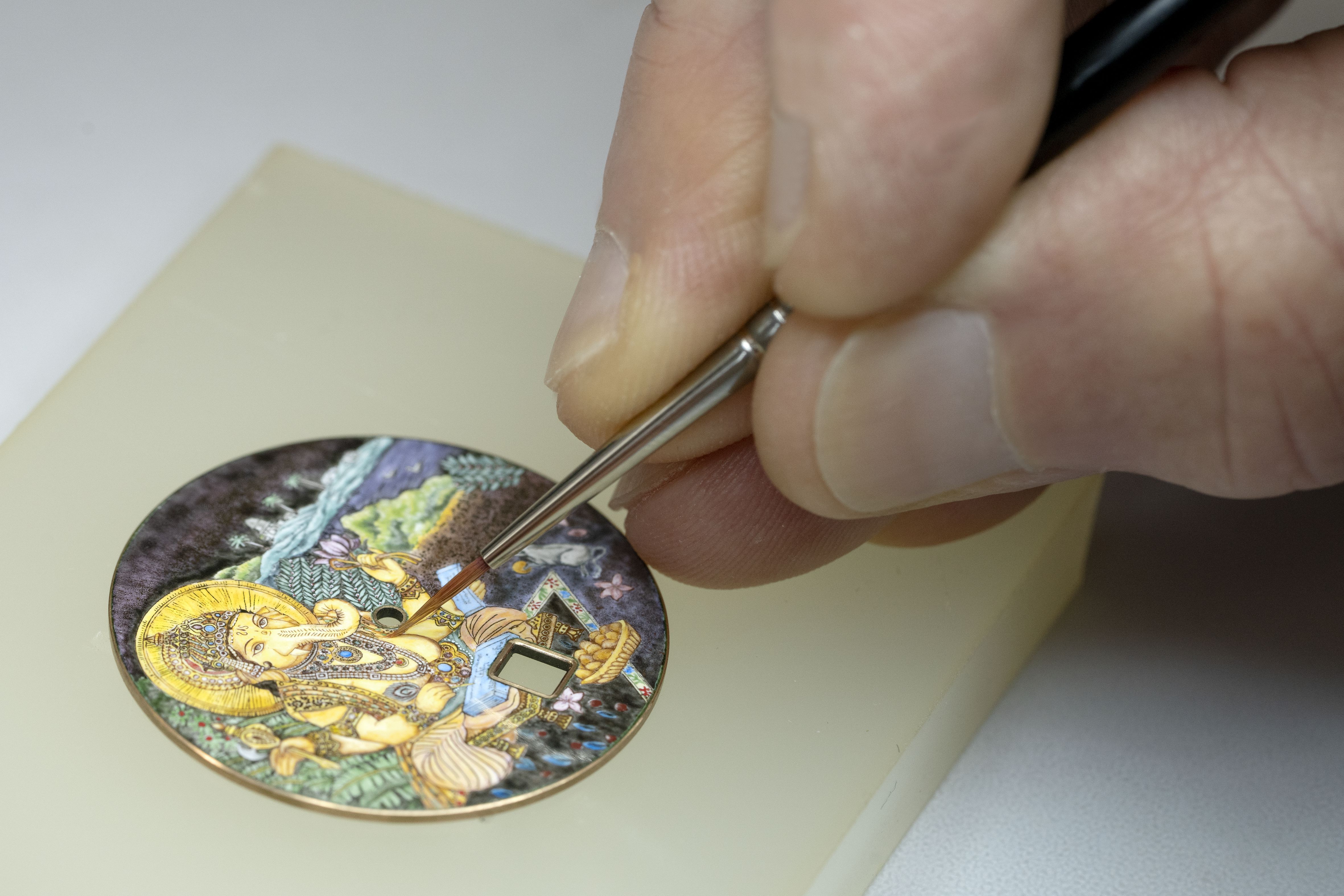
4. Roger Dubuis Excalibur Monobalancier Lord Ganesha Edition - Contemporary Metalized Art
Roger Dubuis's recent collaboration with Art of Time introduces a distinctly modern approach to Ganesha representation. The 42mm pink gold case houses the brand's signature Monobalancier movement, but the dial technique represents an evolution in luxury watch decoration.
Hand-Drawn Metalized Technique: Unlike traditional enamel or lacquer methods, this piece employs direct metallic drawing on sapphire crystal. The artist creates Ganesha's image using metallic compounds suspended in specialized varnishes—pink gold particles for warm tones, contrasting with black and white varnish for definition and depth. The sapphire dial substrate offers unique advantages: absolute flatness for precise drawing, chemical resistance to metallic compounds, and optical clarity that allows light to interact with the metallic particles. The hand-drawing process requires extraordinary steady hands and artistic vision, as mistakes cannot be corrected without complete restart. This technique creates a luminous quality as ambient light reflects off the metallic particles at varying angles, causing Ganesha's form to subtly shift in appearance as the watch moves—a poetic interpretation of the deity's dynamic, ever-present nature.
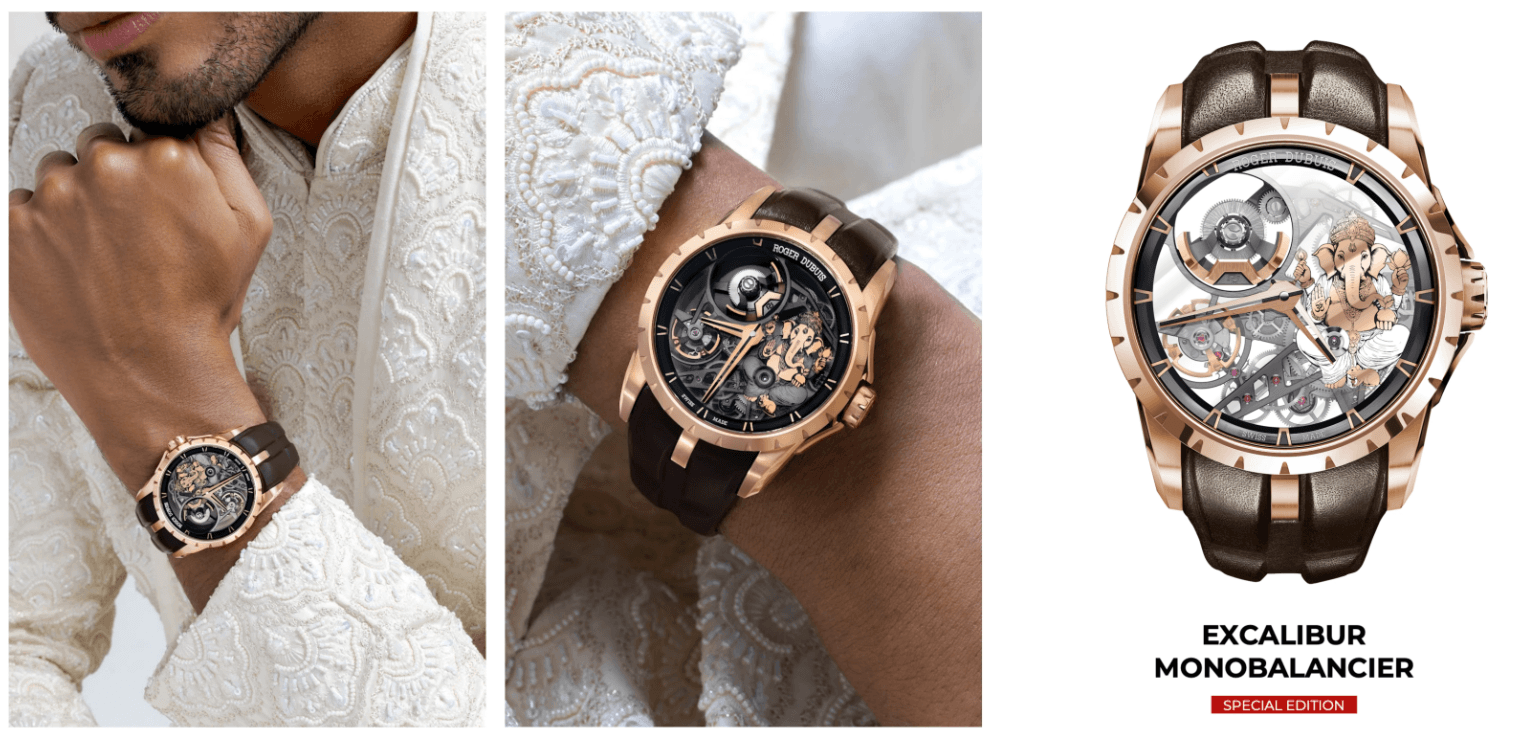
Why Ganesha Watches Remain Exceptionally Rare in Luxury Horology
The scarcity of luxury Ganesha timepieces stems from several converging factors that illuminate both the challenges and opportunities in this niche market segment.
-Technical Complexity: Religious iconography demands extraordinary artistic precision. Ganesha's complex form—with his distinctive elephant head, four arms holding specific attributes, and intricate traditional ornamentation—pushes decorative techniques to their limits. Unlike abstract patterns or simple motifs, religious accuracy requires deep cultural understanding combined with supreme technical skill.
-Cultural Sensitivity: Luxury brands approach religious themes with appropriate reverence, understanding that missteps could offend millions of devotees. This responsibility constrains creative freedom while demanding authentic cultural consultation. The brands that have succeeded invested heavily in cultural advisors and traditional artisans to ensure respectful representation.
-Market Considerations: The intersection of luxury watch collectors and Hindu cultural appreciation represents a specific demographic. Brands must balance universal aesthetic appeal with cultural authenticity, creating pieces that resonate with both Indian collectors and international connoisseurs of decorative arts.
-Artisan Scarcity: The techniques employed in these pieces—shakudō, damascening, maki-e, grand feu enamel—represent dying arts practiced by fewer than a hundred master craftsmen globally. Each piece requires months of work by these specialists, naturally limiting production capacity.
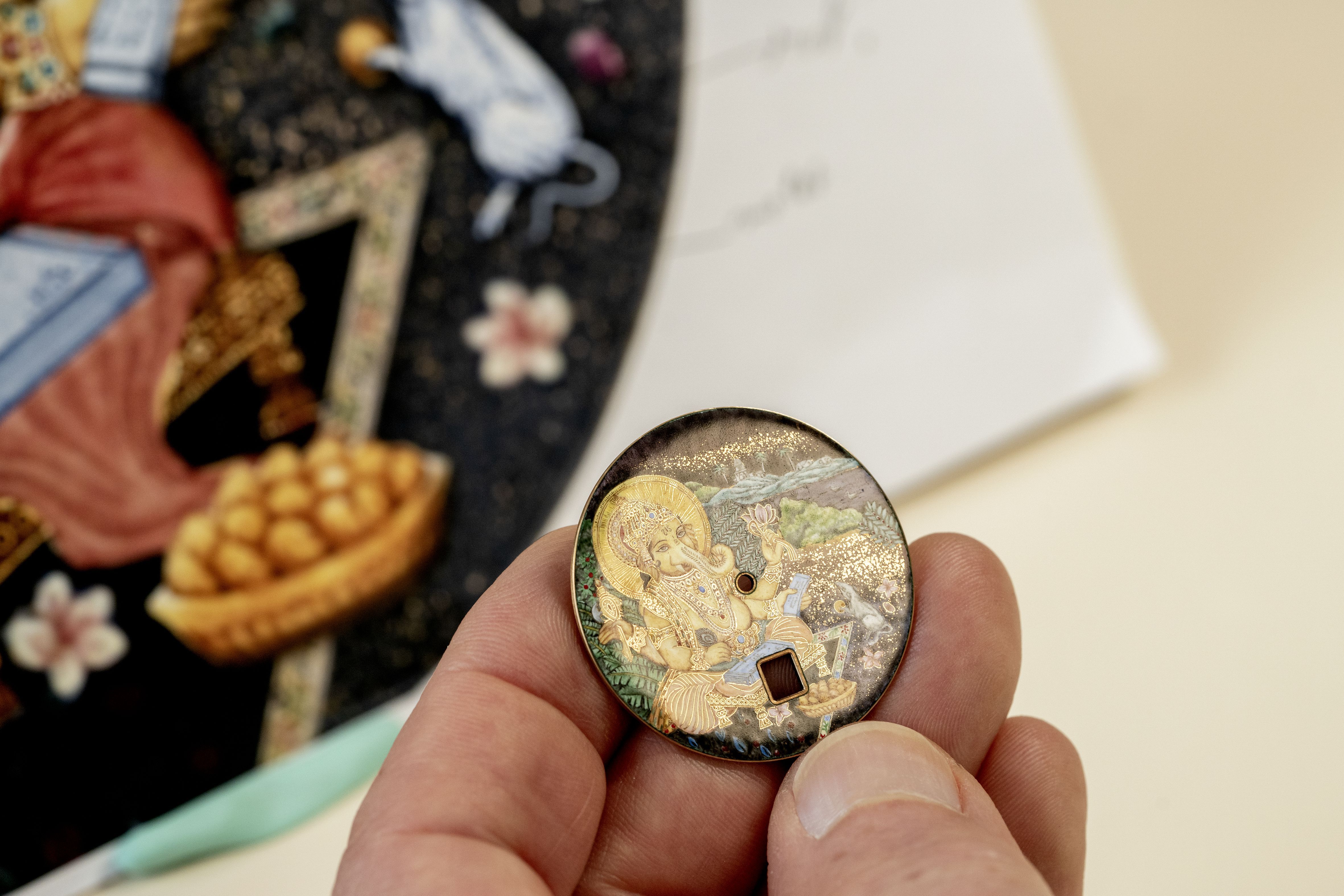
Lord Ganesha's role as the remover of obstacles and patron of new beginnings makes him particularly relevant to luxury timepieces. In Hindu tradition, Ganesha is invoked before commencing any significant endeavor—from business ventures to artistic pursuits. A Ganesha watch thus becomes more than a luxury object; it serves as a spiritual companion for important life moments. The deity's association with wisdom and prosperity aligns naturally with luxury watch ownership psychology. Collectors often view exceptional timepieces as achievements marking professional success or personal milestones—moments when Ganesha's blessings seem particularly appropriate.
Market Dynamics and Future Potential
India's luxury watch market has experienced explosive growth, with annual increases exceeding 15% over the past five years. The emergence of India-specific limited editions from major Swiss brands reflects this growing purchasing power and cultural confidence.
-Cultural Renaissance: India's luxury consumers increasingly seek pieces that reflect cultural heritage rather than purely Western aesthetic values. This trend extends beyond watches to jewelry, automobiles, and art, suggesting sustained demand for culturally relevant luxury goods.
-Technical Innovation Opportunities: The success of Roger Dubuis's metalized drawing technique suggests room for innovation in religious iconography representation. Future developments might include micro-mechanical automata depicting Ganesha's various mudras, or complications that align with Hindu astrological systems.
Ganesha watches occupy a unique position in the luxury timepiece ecosystem. Their extreme rarity, combined with cultural significance and technical excellence, creates multiple value drivers rarely present simultaneously in other luxury watches. The convergence of Swiss horological mastery with Hindu spiritual traditions represents more than mere decoration—it embodies the globalization of luxury while maintaining deep cultural authenticity. As India's influence in global luxury markets continues expanding, these pioneering pieces may well be remembered as the foundation of an entirely new collecting category.
As Ganesh Chaturthi celebrations continue across India and Hindu communities worldwide, these four exceptional timepieces remind us that true luxury transcends mere material value. They represent the highest expression of human craftsmanship dedicated to spiritual beauty—Swiss precision serving divine artistry. Each technique employed demonstrates how traditional methods can honor timeless spiritual concepts. These watches don't merely tell time; they preserve cultural heritage through mechanical poetry, ensuring that future generations can witness the profound respect these Swiss masters held for Hindu tradition.
No articles found


